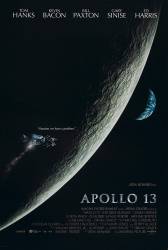Factual error: When they're flying around the backside of the moon, they mention the Tsiolkovskiy crater on the lunar farside, then mention they can see Mare Tranquillitatis and Fra Mauro - which are on opposite sides of the moon.
Suggested correction: The moon is a globe, not a disk. If you are in orbit around it, you will see features on both "sides" of the moon at the same time. You won't suddenly go from seeing only features on the far side of the moon to seeing only features on the near side of the moon.
Factual error: In the movie, Henry tells a White House rep that Blackout lasts for 3 minutes, and if they are not back in 4, then they'll know they didn't survive. This is actually not correct. During the Apollo program, blackout typically lasted about 4 minutes. Also, Apollo 13's re-entry blackout in fact lasted 6 minutes, not 4 as seen in the movie, which was 87 seconds longer than predicted.
Factual error: In the scene where Marilyn Lovell is in her backyard and she looks up at the jet flying over her house (presumably her husband), there is a contrail behind it. The jet is at too low of an altitude to produce a contrail.
Factual error: The Apollo 13-Saturn V vehicle was rolled out to the launch pad on 16 Dec 1969, not two days before launch, as portrayed.
Factual error: During the final voiceover, Jim Lovell says "Fred Haise was going back to the moon on Apollo 18, but his mission never flew." In reality, it was Apollo 19, not 18, that Haise was tentatively chosen to command.
Factual error: The remaining smoke plume after the Saturn V liftoff is about 80 miles too low. It's apparent that an aircraft flew over the space center to leave a feeble 'movie' plume. Also, when the Apollo 13 crew blasts out of Earth orbit, the ship is pointed straight at the Moon, meaning that once they travelled the 240,000 miles to the Moon's orbit path, the Moon would be several thousand miles to their left.
Factual error: Hanks as Lovell drives a red corvette. The real Lovell has said in interviews he drove a blue corvette.
Factual error: At the end of the movie, when the astronauts debark from the helicopter and are surrounded by the crew of the U.S.S. Iwo Jima, there are a number of junior enlisted men wearing combination caps. (The type worn by Chief Petty Officers and commissioned officers.) That they are junior enlisted men is obvious by the rank insignia on their left sleeves and by the silver USN and Eagle emblem on their caps. (Chief's caps have a large gold and silver anchor insignia, and officer's caps have a large gold officer's crest.) The U.S. Navy did, for a few years, replace the junior enlisted men's traditional white hat with the combination cap, but the change was not announced until 1972, two years after the Apollo 13 mission, and the Navy reverted to white hats in 1983, twelve years before the movie was made.





